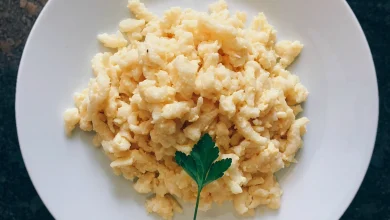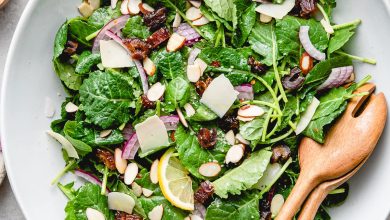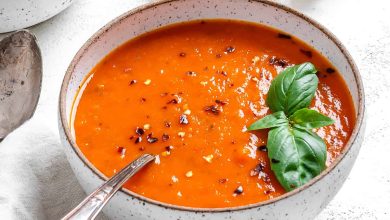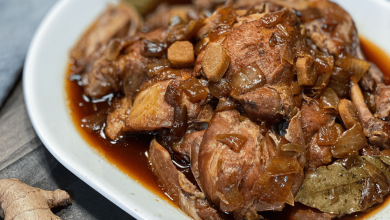Thai Vegetable Red Curry
Certainly, I’d be happy to provide you with detailed information about Thai Vegetable Red Curry.
What is Thai Vegetable Red Curry?
Thai Vegetable Red Curry, also known as “Kaeng Phed” or “Red Curry” in Thai, is a popular Thai dish that features a rich and aromatic red curry paste cooked with a variety of vegetables. It’s a flavorful and spicy dish that is often served with rice. While it can be made with various proteins like chicken, shrimp, or tofu, I’ll provide you with a vegetarian version here.
History:
Red Curry is a staple in Thai cuisine, and its origins can be traced back to Thailand. The use of curry paste and coconut milk in Thai cooking can be dated to as early as the 13th century. Over the years, the recipe has evolved, and today it’s enjoyed not only in Thailand but also worldwide.
Components:
Here are the key components of Thai Vegetable Red Curry:
Ingredients:
For the Red Curry Paste:
- 2-3 red Thai chilies (adjust to your spice preference)
- 2 shallots, chopped
- 3 cloves garlic, minced
- 1-inch piece of galangal or ginger, chopped
- 1 lemongrass stalk, chopped (only the white part)
- 1 tsp coriander seeds
- 1/2 tsp cumin seeds
- 1/2 tsp paprika
- 1/2 tsp shrimp paste (optional, for authentic flavor)
For the Curry:
- 1 can (14 oz) of coconut milk
- 2 cups mixed vegetables (such as bell peppers, carrots, zucchini, and bamboo shoots)
- 1 cup tofu, cubed (optional)
- 2 tbsp vegetable oil
- 1-2 tbsp soy sauce
- 1-2 tbsp brown sugar
- Fresh basil leaves for garnish
- Lime wedges for serving
Steps to Prepare Thai Vegetable Red Curry:
-
Prepare the Red Curry Paste:
a. In a dry pan, toast the coriander and cumin seeds until fragrant.
b. In a blender or mortar and pestle, combine the toasted seeds, red Thai chilies, shallots, garlic, galangal (or ginger), lemongrass, paprika, and shrimp paste (if using).
c. Blend or pound until you have a smooth paste. -
Cook the Curry:
a. Heat vegetable oil in a large pan over medium heat.
b. Add 2-3 tablespoons of the red curry paste (adjust to your spice preference) and sauté for a couple of minutes until fragrant. -
Add Vegetables and Tofu:
a. Add the mixed vegetables and tofu (if using) to the pan. Stir-fry for a few minutes until they start to soften. -
Add Coconut Milk:
a. Pour in the can of coconut milk and stir well to combine with the vegetables and tofu. -
Season and Simmer:
a. Season the curry with soy sauce and brown sugar. Adjust the seasoning to your taste.
b. Let the curry simmer for about 10-15 minutes, or until the vegetables are tender and the flavors meld together. -
Serve:
a. Garnish the Thai Vegetable Red Curry with fresh basil leaves.
b. Serve hot with steamed jasmine rice and lime wedges on the side.
Time Needed:
The total time needed to prepare Thai Vegetable Red Curry is approximately 30-40 minutes, including preparation and cooking time. It’s a relatively quick and delicious dish to make, perfect for a flavorful meal.
I hope you find this recipe enjoyable and that it meets your expectations for a detailed response. If you have any more questions or need further assistance, please feel free to ask.
Certainly, here are the nutrition facts and some health information for Thai Vegetable Red Curry (vegetarian version). Please note that these values are approximate and can vary based on specific ingredients and serving sizes:
Nutrition Facts (Per Serving):
- Calories: Approximately 350-400 calories per serving.
- Protein: Around 5-10 grams per serving (varies based on tofu and vegetable content).
- Carbohydrates: Approximately 20-30 grams per serving.
- Dietary Fiber: Roughly 4-6 grams per serving.
- Fat: About 25-30 grams per serving (mainly from coconut milk and oil).
Health Information:
-
Rich in Vegetables: Thai Vegetable Red Curry is packed with a variety of colorful vegetables, providing essential vitamins, minerals, and dietary fiber. These vegetables offer antioxidants that can help protect your cells from damage.
-
Coconut Milk: While coconut milk adds a creamy and delicious texture to the curry, it’s also relatively high in calories and saturated fats. However, it contains medium-chain triglycerides (MCTs), which some studies suggest may have potential health benefits, including aiding in weight management and providing a quick source of energy.
-
Protein Source: If you include tofu in your curry, it becomes a good source of plant-based protein. Tofu is low in saturated fat and an excellent option for vegetarians and vegans looking to meet their protein needs.
-
Spices: The use of spices like red chilies, ginger, and garlic in the curry paste not only adds flavor but may also have potential health benefits. For instance, ginger is known for its anti-inflammatory properties, while garlic is believed to have various health benefits, including supporting the immune system.
-
Customizable: You can adjust the ingredients and spice level to suit your dietary preferences and spice tolerance. For a healthier version, consider reducing the amount of coconut milk or choosing a light coconut milk option.
-
Serving Tips: To make the meal even healthier, serve Thai Vegetable Red Curry with brown rice or quinoa for added fiber and nutrients. You can also squeeze fresh lime juice over the curry for a burst of vitamin C.
It’s worth noting that while this dish is nutritious and provides several health benefits, the calorie and fat content can be relatively high due to the coconut milk. Moderation is key, and it can be part of a balanced diet when enjoyed occasionally.
As always, for specific dietary concerns or personalized nutritional advice, it’s a good idea to consult with a healthcare professional or registered dietitian.








